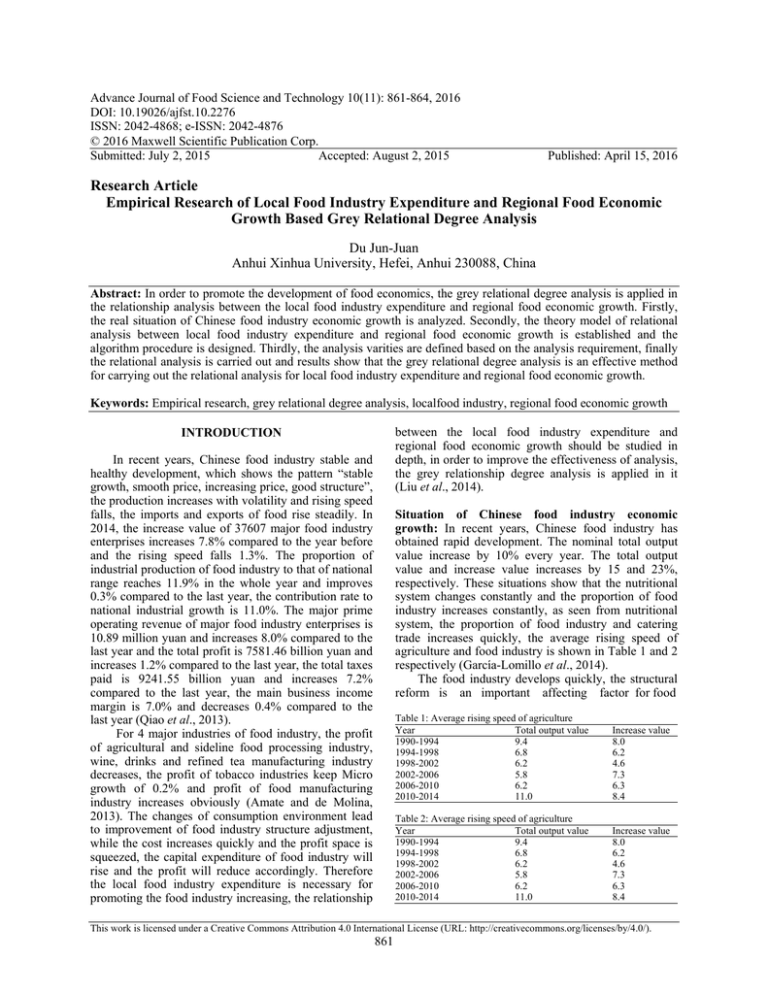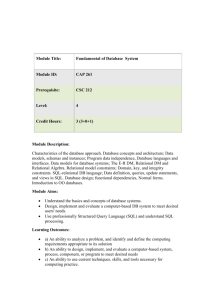Advance Journal of Food Science and Technology 10(11): 861-864, 2016
advertisement

Advance Journal of Food Science and Technology 10(11): 861-864, 2016
DOI: 10.19026/ajfst.10.2276
ISSN: 2042-4868; e-ISSN: 2042-4876
© 2016 Maxwell Scientific Publication Corp.
Submitted: July 2, 2015
Accepted: August 2, 2015
Published: April 15, 2016
Research Article
Empirical Research of Local Food Industry Expenditure and Regional Food Economic
Growth Based Grey Relational Degree Analysis
Du Jun-Juan
Anhui Xinhua University, Hefei, Anhui 230088, China
Abstract: In order to promote the development of food economics, the grey relational degree analysis is applied in
the relationship analysis between the local food industry expenditure and regional food economic growth. Firstly,
the real situation of Chinese food industry economic growth is analyzed. Secondly, the theory model of relational
analysis between local food industry expenditure and regional food economic growth is established and the
algorithm procedure is designed. Thirdly, the analysis varities are defined based on the analysis requirement, finally
the relational analysis is carried out and results show that the grey relational degree analysis is an effective method
for carrying out the relational analysis for local food industry expenditure and regional food economic growth.
Keywords: Empirical research, grey relational degree analysis, localfood industry, regional food economic growth
between the local food industry expenditure and
regional food economic growth should be studied in
depth, in order to improve the effectiveness of analysis,
the grey relationship degree analysis is applied in it
(Liu et al., 2014).
INTRODUCTION
In recent years, Chinese food industry stable and
healthy development, which shows the pattern “stable
growth, smooth price, increasing price, good structure”,
the production increases with volatility and rising speed
falls, the imports and exports of food rise steadily. In
2014, the increase value of 37607 major food industry
enterprises increases 7.8% compared to the year before
and the rising speed falls 1.3%. The proportion of
industrial production of food industry to that of national
range reaches 11.9% in the whole year and improves
0.3% compared to the last year, the contribution rate to
national industrial growth is 11.0%. The major prime
operating revenue of major food industry enterprises is
10.89 million yuan and increases 8.0% compared to the
last year and the total profit is 7581.46 billion yuan and
increases 1.2% compared to the last year, the total taxes
paid is 9241.55 billion yuan and increases 7.2%
compared to the last year, the main business income
margin is 7.0% and decreases 0.4% compared to the
last year (Qiao et al., 2013).
For 4 major industries of food industry, the profit
of agricultural and sideline food processing industry,
wine, drinks and refined tea manufacturing industry
decreases, the profit of tobacco industries keep Micro
growth of 0.2% and profit of food manufacturing
industry increases obviously (Amate and de Molina,
2013). The changes of consumption environment lead
to improvement of food industry structure adjustment,
while the cost increases quickly and the profit space is
squeezed, the capital expenditure of food industry will
rise and the profit will reduce accordingly. Therefore
the local food industry expenditure is necessary for
promoting the food industry increasing, the relationship
Situation of Chinese food industry economic
growth: In recent years, Chinese food industry has
obtained rapid development. The nominal total output
value increase by 10% every year. The total output
value and increase value increases by 15 and 23%,
respectively. These situations show that the nutritional
system changes constantly and the proportion of food
industry increases constantly, as seen from nutritional
system, the proportion of food industry and catering
trade increases quickly, the average rising speed of
agriculture and food industry is shown in Table 1 and 2
respectively (García-Lomillo et al., 2014).
The food industry develops quickly, the structural
reform is an important affecting factor for food
Table 1: Average rising speed of agriculture
Year
Total output value
1990-1994
9.4
1994-1998
6.8
1998-2002
6.2
2002-2006
5.8
2006-2010
6.2
2010-2014
11.0
Increase value
8.0
6.2
4.6
7.3
6.3
8.4
Table 2: Average rising speed of agriculture
Year
Total output value
1990-1994
9.4
1994-1998
6.8
1998-2002
6.2
2002-2006
5.8
2006-2010
6.2
2010-2014
11.0
Increase value
8.0
6.2
4.6
7.3
6.3
8.4
This work is licensed under a Creative Commons Attribution 4.0 International License (URL: http://creativecommons.org/licenses/by/4.0/).
861
Adv. J. Food Sci. Technol., 10(11): 861-864, 2016
Table 3: Performance of food industry
Industrial added value rate/%
Food processing industry
20.32
Food manufacturing industry
27.43
Beverage manufacturing industry 37.23
Tobacco processing industry
74.19
Light industry average
39.25
Industry average
24.10
industry, Chinese state food enterprises occupy 27% of
all food enterprise, the proportion of foreign-funded
enterprises has biggest proportion, the foreign-funded
enterprises not only change the constitution of
ownership, but also promote foreign communication
and technological advances, the reform of ownership
increases the capital investment and the variety of food
is more plentiful and output of food production
increases constantly and the service range is expanding
(Handford et al., 2014).
In recent years, the sum of fixed assets-net value
and annual surplus of the current assets for food
industry increases quickly (Seck et al., 2013). The
expanding of capital total sum can buy more advanced
technical devices and improve the productivity of labor
and improve the quality of food production and add
new food production. Under support of local food
industry expenditure, the new technologies are used in
developing the food industry, a lot of new food
technologies emerge accordingly, such as biological
engineering, gas, fresh, cold dry, microwave,
irradiation, membrane separation, extraction, extrusion,
puffing, then the production efficiency of food industry
can be improved and the food product quality can be
amended. Achievement of mechanization, automation
and continuous can promote the section energy, low
consumption and increasing value, the new
technologies can reduce the consumption coefficients of
farm produce for food industry. The performance of
food industry is shown in Table 3 in 2014.
Asset contribution factor/%
6.50
7.29
11.19
39.54
9.50
8.21
0i (k ) | x0 j (k ) xi (k ) |
(3)
min min min | x0 j ( k ) xi ( k ) |
(4)
max max max | x0 j ( k ) xi ( k ) |
(5)
i
k
i
k
The grey relational grade can be expressed as follows:
n
( x0 j , xi ) k ( x0 j (k ), xi (k ))
(6)
k 1
where ωk is the weight value, which can be obtained
based on the following steps:
Step 1 : Choose the mother and sub indexes, the
critical index in the project evaluated can be
considered as mother index and the vector of
index value corresponding to the mother index
can be defined as follows:
Y0 ( x10 , x20 , , xn 0 )T
(7)
where, Y0 is the mother series.
The other factors can be used as sub indexes,
the vector of index value corresponding to sub
indexes can be defined by (Kolar and
Kammenou, 2013):
xi ( k ) , i = 1, 2,…,m; k = 1, 2,…,n; j = 1, 2 (1)
x0 j ( k )
Y j ( x1 j , x2 j , , xnj )T
(8)
where, Yj is sub series.
where,
x*i
= The normalized series
xi (k)
= The original series
x0j (k) = The reference series
Step 2 : The original process is carried out for Y0 and
Yj, which is expressed as follows:
The grey relational coefficient can be computed
based on formula (1). The grey relational coefficient of
unknown xi for x0j can be expressed as follows:
min max ,
0i (k ) max
0 ( x0 j (k ), xi (k )) 1
Deficiency/%
2.23
1.84
1.63
1.44
1.46
1.39
where, η is the distinguishing factor, which can show
the relational degree between x0j(k) and xi(k), η = 0.5 in
this research; Δ0i(k) is the deviation series of the
reference series, the test series:
Theory model of relational analysis between local
food industry expenditure and regional food
economic growth: The linear data pre-processing
method can be expressed as follows:
xi*
Profit rate of cost/%
0.94
1.24
7.53
19.53
4.53
3.29
xi' 0
( x0 j (k ), xi (k ))
xij'
(2)
862 xi 0
x10
xij
x1 j
(9)
(10)
Adv. J. Food Sci. Technol., 10(11): 861-864, 2016
'
'
Then Y0' (x10
, x20
,, xn' 0 )T , Yj' (x1' j , x2' j ,, xnj' )T
and the original index matrix is confirmed,
B (Y0' , Y j' ) .
Step 2 : Process the parameters. The difference
sequences of X'i to X'j can be expressed as
follows:
i , j [ i , j (1), i , j (2), , i , j (10)]
Step 3 : The relational coefficient between Y0 and Yj is
computed according to the following
expression (Zeng et al., 2013):
yij
where, i , j () | xi' () x 'j () | , the collection of
difference sequences is defined by { i , j } .
min min | xi' 0 xij' | max max | xi' 0 xij' |
1 j m 1i n
'
i0
1 j m 1i n
The environmental parameter is expressed as
follows:
| x xij' | max max | xi' 0 xij' |
1 j m 1i n
(11)
And the relational matrix is confirmed, which
is defined by:
Y { yij }nm
yi
1 n
yij , j 1,2, , m
n i 1
(13)
k
m
y
k 1
(15)
The computing flow is shown as follows:
Step 1 : Process the original like value. Because Xi
sequence can reflect the value with different
magnitude, in order to eliminate the effects of
dimensions and the original like value is
carried out for Xi, the following expression is
obtained:
(16)
j
(min) (max)
i , j () (max)
(20)
Then the grey relational degree is calculated
by the following expression:
i, j
Algorithm procedure of relational analysis: The grey
system can be established using variables of investment
in science and technology and economics growth,
which is defined by {Xi, Xj, …}, i, j denote different
variables, where, Xi is the value of variable i from 2004
to 2013, which is expressed as follows (Peng and Zeng,
2014):
Xi
[ xi' (1), xi' (2), , xi' (10)]
xi (1)
(19)
i , j ()
(14)
Then the grey relational degree can be acquired,
which can show the relational degree between the
reference series and testing series.
X i'
(min) min min{min i , j ()}
j
The identification coefficients is defined by ε,
ε = 0.5 in this research.
Step 3 : Calculate the relational degree. The grey
relational coefficient can be expressed as
follows:
k
X i [ xi (1), xi ( 2), , xi (10)]
(18)
i
Step 5: The normalization is used to cope with y'j and
the weighting value is confirmed by the
following expression (Dong and Guo, 2014):
yk , k 1, 2, , m
(max) max max{max i , j ()}
i
(12)
Step 4 : Compute the average value of column for the
relational matrix, which is defined by:
(17)
1 10
ri , j ()
10 1
(21)
Experiment design: In order to verify the effectiveness
of theory model of relational analysis, the food industry
data in a province is used as example and
corresponding relational analysis is carried out.
Main indexes: The Regional Food Economic Growth
(RFEG) is denoted by the total output of food industry
(unit: billion yuan), this method exists a certain
limitation, for example the negative effect led by
regional food economic growth during the procession
of statistics can not be considered, however this method
is easy to use, the price fluctuation is ignored during the
procession of analysis (Kolar and Kammenou, 2013).
The Local Food Industry Expenditure (LFIE) is
used as a variable. This variable chooses total
expenditure of food industry in this province (unit:
million yuan). This index can measure the local food
industry expenditure in this province, the food industry
expenditure is main used in relating technical research
and development, which is supported by local
government of this province, enterprise capital and
financial institution loan (Zhou et al., 2014).
863 Adv. J. Food Sci. Technol., 10(11): 861-864, 2016
RESULTS AND DISCUSSION
The RFEG is defined by X0, the LFIE is defined by
X1, the investment of private capital is defined by X2. X0
belongs to mother series, X1 and X2 are sub series and
the value of them are shown by the following vectors:
X0 = [165433.2, 165378, 204246, 265438, 296743,
315438, 387361, 457852, 506732, 575198]
X1 = [1863, 2254, 2973, 4542, 4164, 5582, 6759,
8582, 9727, 10542]
X2 = [29.6, 30.3, 32.6, 33.5, 36.1, 35.8, 40.3, 42.0,
43.0, 42.5, 46.3]
Then final results can be obtained through
processing in further, which are shown by the
following:
X'0 = [1.0, 1.12, 1.26, 1.47, 1.79, 2.11, 2.38, 2.88, 3.18,
3.32]
X'1 = [1.0, 1.16, 1.37, 2.38, 2.49, 2.86, 3.42, 4.54, 5.17,
5.89]
X'2 = [1.0, 1.15, 1.26, 1.37, 1.42, 1.49, 1.53, 1.67, 1.73,
1.84]
The difference series of X'0 to X'1 are defined by:
Δ0,1 = [Δ0,1 (1), Δ0,1 (2),…, Δ0,1(10)] = [0, 0.12, 0.26,
0.78, 0.42, 0.79, 1.14, 1.67, 1.82, 2.43]
The difference series of X'0 to X'2 are defined by:
Δ0,2 = [Δ0,2 (1), Δ0,2 (2),…, Δ0,2(10)] = [0, 0.09, 0.21,
0.46, 0.72, 0.83, 1.26, 1.39, 1.69, 1.86]
Based on expressions (20) and (21), the relative
relational degrees γ0,1 and γ0,2 are computed, the final
results are shown as follows:
γ0,1 = 0.854, γ0,2 = 0.739
According to the results, the local food industry
expenditure is more important for regional food
economic growth than private capital, the positive
correlation degree between local food industry
expenditure and regional food economic growth is
stronger.
CONCLUSION
Chinese food industry has entered an optimal
developing period, which has more chances. Through
improving local food industry expenditure, the
technology can be improved, the management level can
be improved and the food industry structure can be
updated. Then the food industry can achieve quick
economic growth, the industrial output value of food
industry can be improved accordingly, Chinese food
industry can obtain strong competitive advantage. The
grey relational analysis can be applied in analyzing the
relational characteristic between the local food industry
expenditure and economic growth effectively.
REFERENCES
Amate, J.I. and M.G. de Molina, 2013. 'Sustainable degrowth'in agriculture and food: An agro-ecological
perspective on Spain's agri-food system (year
2000). J. Clean. Prod., 38(1): 27-35.
Dong, S.W. and Q.S. Guo, 2014. Grey relational degree
method-based badminton development research.
BioTechnol. Indian J., 10(5): 1231-1237.
García-Lomillo, J., M.L. González-SanJosé, R. Del
Pino-García, M.D. Rivero-Pérez and P. MuñizRodríguez, 2014. Antioxidant and antimicrobial
properties of wine byproducts and their potential
uses in the food industry. J. Agr. Food Chem.,
62(52): 12595-12602.
Handford, C.E., M. Dean and M. Henchion, M. Spence,
C.T. Elliott and K. Campbell, 2014. Implications of
nanotechnology for the agri-food industry:
Opportunities, benefits and risks. Trends Food Sci.
Tech., 40(2): 226-241.
Kolar, P. and M. Kammenou, 2013. Future food
research and innovation under Horizon 2020
(2014-2020). Int. J. Trade Global Markets, 6(1):
66-82.
Liu, Y., D.Z. Wang, X.S. Len and Y.Z. Xiong, 2014.
Study on frozen food industry's integrated
information management strategy based on ERP.
Adv. J. Food Sci. Technol., 6(11): 1249-1254.
Peng, X.H. and H. Zeng, 2014. Swimming techniques
quantitative analysis research based on grey
relational degree model. BioTechnol. Indian J.,
10(3): 567-673.
Qiao, C.T., R. Xiao and L.D. Yan, 2013. Green food
industry and quality of economic growth in China:
The positive analysis based on granger causality
test and variance decomposition. Adv. J. Food Sci.
Technol., 5(8): 1059-1063.
Seck, G.S., G. Guerassimoff and N. Maïzi, 2013. Heat
recovery with heat pumps in non-energy intensive
industry: A detailed bottom-up model analysis in
the French food and drink industry. Appl. Energ.,
111(11): 489-504.
Zeng, Y.Y., F.J. Kang and X. Hao, 2013. Improved
PSO algorithm for multi-objective optimization
based on grey relational degree. ICIC Express
Lett., 7(1-6): 601-607.
Zhou, Q.S., Y.L. Xu, T. Wang and L.P. Chen, 2014.
Parallel factor analysis in dual-class tax impacts of
agricultural products: An economic research from
macro perspective. Adv. J. Food Sci. Technol.,
6(8): 984-988.
864




